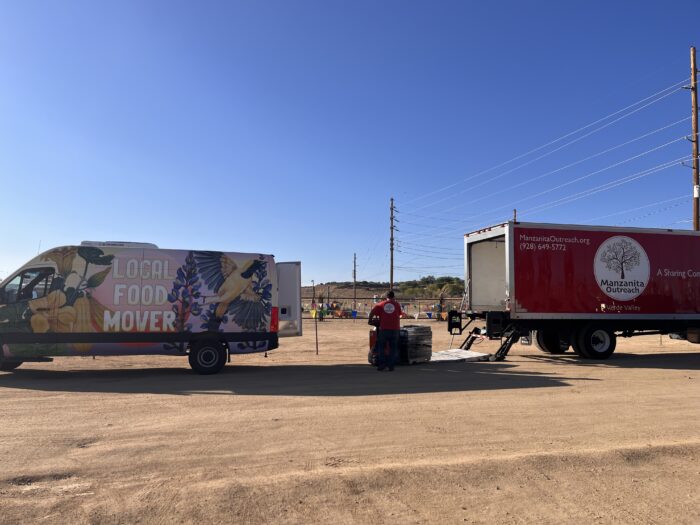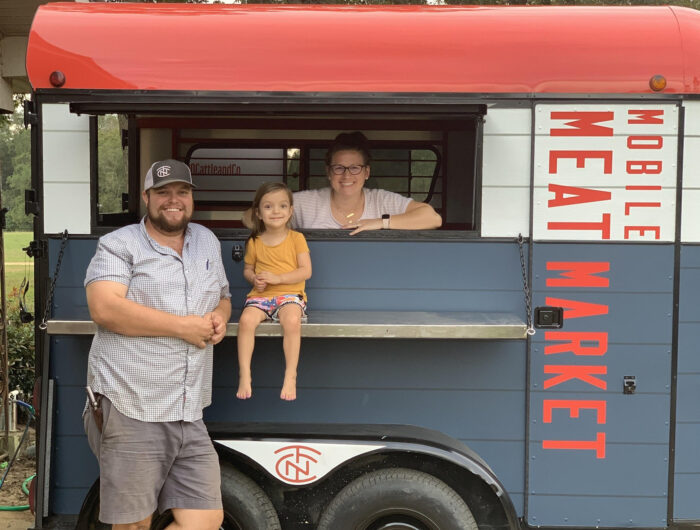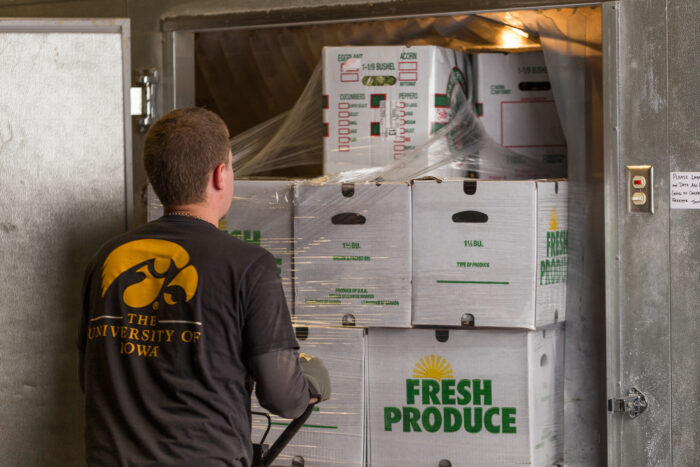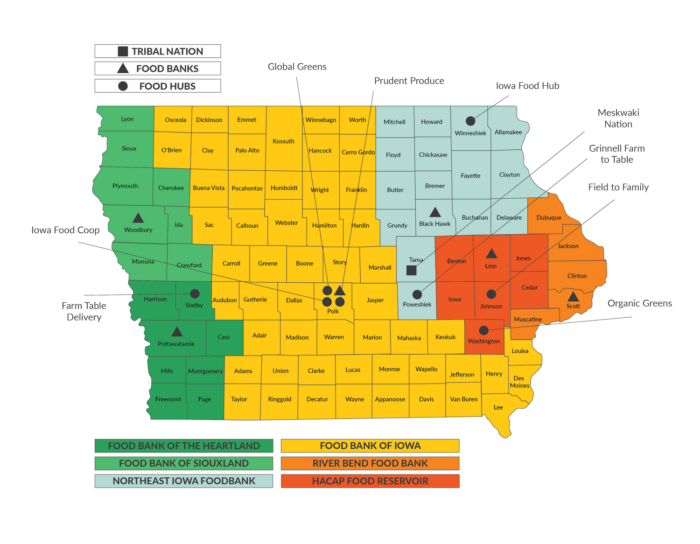
Editor’s Note: This blog post is the first post in a series highlighting how recent supply chain investments were unique and pivotal in expanding infrastructure to respond to growing farmer demand, reducing costly wait times, and reaching diversified operations. Part Two and Three will move further along the supply chain, taking a deeper look at how essential technical assistance, value-chain coordination, and market opportunities support the success of efficient regional food systems.
Local farmers play an essential role in keeping our communities fed and thriving. While individuals can readily buy freshly harvested items from farmers at the farmers’ market, options for accessing local food are expanding. Thanks in large part to recent USDA food system investments, families can increasingly find it in local grocery stores, restaurants, and schools.
Investments made through the 2018 Farm Bill and pandemic aid tested concepts, vetted business viability, and equipped organizations with the knowledge and capacity to effectively manage regional supply chains. Communities nationwide showcased how such investments in their local food supply chains created new regional business opportunities and generated broader community benefits.
As a number of new USDA programs unfolded in 2023, NSAC staff conducted interviews with technical assistance providers, food hubs, farmers, processors, and more to understand the implications of these programs on the ground.
Recent History in Regional Market Investments and Growth
According to the recently released Census of Agriculture, 60,332 farms sold their products to retail markets, institutions, and food hubs marketed as local and regional products in 2022. This is more than double the 28,958 farms that sold into these channels in 2017, the last time the census was conducted, corresponding with an increase in sales from $9 billion to $14.2 billion.
The local and regional food systems that support this network of local producers, retailers, and consumers are receiving growing recognition and support for their unique contributions. Because of this and pandemic-related instability in 2021, President Biden issued an executive order to strengthen supply chains, and with funding authorized under the American Rescue Plan Act, USDA’s Agricultural Marketing Service (AMS) began implementation of their supply chain transformation initiative in 2022.
The COVID-19 pandemic exposed the fractures in our domestic supply chains and the fragility of a “get big or get out” approach to processing and aggregation systems, particularly in meat processing. Continuing to invest in essential points along the supply chain, like processing and aggregation infrastructure, that enable more small and mid-sized farmers to move their food to market safely and economically, will increase the resilience of our food supply chain.
Advocacy from NSAC and other stakeholders around these issues led to targeted infrastructure investments that sought to: improve processing capacity and choice for farmers who are smaller or utilizing more sustainable feed and rearing techniques; increase the availability of localized and scale-appropriate cold storage for rural communities; and support mid-tier aggregation and distribution activities. However, many of these programs have already spent their allotted funds or will expire by 2025.
Meat and Poultry Processing Expansion Program: This grant program invests in small to midsize meat processing operations, allowing them to expand their capacity to process for local and regional markets.
Meat and Poultry Intermediary Loan Program: This program provides initial capital grants to economic development groups, banks, and other nonprofit organizations to finance projects that specifically target and offer beneficial loan terms to smaller meat processing operations.
Local Meat Capacity Grants: This grant supports independently owned meat and poultry processing businesses with funds to provide more and better processing options for local livestock producers by modernizing, increasing, diversifying, and decentralizing meat and poultry processing capacity, including support for rendering.
Meat and Poultry Inspection Readiness Grants: This grant assisted currently operational meat and poultry slaughter and processing facilities in obtaining a Federal Grant of Inspection or to operate as a State-inspected facility that is compliant with federal law under the Cooperative Interstate Shipment (CIS) program.
Indigenous Animal Processing Grants: This grant funds projects to restore local indigenous food systems and indigenous processing methods, and invest in Tribal Nations’ supply chain resiliency by increasing local capacity for the harvesting, processing, manufacturing, storing, transporting, wholesaling, or distribution of culturally appropriate food.
Food Supply Chain Guaranteed Loan Program: This program incentivizes institutions to finance businesses along the middle of the supply chain to spur the creation or expansion of aggregation, distribution, and processing activities.
Resilient Food System Infrastructure Program: This program provides grant funding to States and territories to invest in specialty crop producers and the middle of the supply chain to meet and scale the growing demand for local products.
Infrastructure Building Success from the Ground Up: Stories from the Field

Processing Expansion Speeds Procurement
In the southeast, an investment success story is the 920 Cattle Company + 3F Processing, started in 2014 by Jarrod and Becca Creasy shortly after their marriage. Jarrod and Becca grew up in agricultural communities and therefore understood some of the key bottlenecks to operating a sustainable ranching and farming business. Initially, their farm started as a seedstock operation, with their first meat sales coming as a natural offlet of that operation. But as the meat sales portion of their operation grew, they recognized some key bottlenecks to its growth.
Chief amongst those was market differentiation and access to reliable processing. For several years after starting their ranch, they relied on a local processor to the north of their operation, Fries Frozen Foods, near Millen, Georgia owned by a neighbor, Mr. Robert “Bobby” Fries. In an unusual move, when they came to deliver a steer for processing in 2016, Mr. Bobby presented them with the opportunity to purchase the processing operation. After much thought, they purchased Fries Frozen Foods, now 3F Processing, utilizing a mixture of USDA loans and their own working capital. This opened up new doors for the growth of their business, and the growth of their local, historically economically distressed community more broadly.
920 Cattle expanded and diversified – starting to raise a variety of livestock including heritage hogs, sheep, along with their original mixture of Hereford and Brangus. Diversifying farm revenue with a variety of crops and livestock can be essential to smaller operations. It is equally important for producers to have the ability to offer a variety of value-added products to their markets, and the multi species, inspected processing 3F could offer is critical to doing so at scale.
“Diversity is integral to the success of our business model, from what we process, who we work with, where people are, how and who we sell to,” said Becca Creasy.
In 2022 and 2023, 920 Cattle received a series of investments and a procurement opportunity that helped them further support the development of their region. 920 Cattle was awarded both a Value-Added Processing Grant (VAPG) and a loan from the Georgia Meat and Poultry Processing Facility Revolving Loan Fund to 3F Processing The VAPG working capital grant allowed them to explore the potential for value-added beef products in their local community, improve their marketing of these products, and plan out different retail channels, while the MPILP loan will provide an additional 12,000 square feet of processing space and an additional retail shop.
“Without these investments, we wouldn’t have been able to scale in the way we have, and definitely not as quickly,” said Becca.
These investments also prepared them to be better able to act as the key processor for the protein supply chain for the Local Food Purchase Assistance Program administered by the Georgia Department of Agriculture. In the last quarter of 2023, 3F Processing provided 55,000 pounds of beef from a variety of socially disadvantaged producers across Georgia. For many of those producers, it was likely their first time being able to be involved in procurement at this scale, because of barriers to entry at the federal level. They are set to process and sell over 300,000 lbs of ground beef through the rest of their contract, all of which is delivered to food banks and pantries in Georgia to supply nutritious protein options to those most in need .

Rural Cold Storage Innovation
Giselle Bruskewitz shared how the Local Food Purchase Assistance (LFPA) Cooperative Agreement Program enabled her organization, Iowa Valley Resource Conservation and Development (IVRCD), to strengthen food infrastructure across Iowa. Since 1998, IVRCD has sought to improve access to local foods by providing direct support to farmers and creating new markets for their products. Giselle first learned of LFPA funding through an email NSAC sent to coalition members. She then worked with her team to advocate for Iowa’s Department of Agriculture (IDALS) to apply for the funds with food hubs in mind as key distributors. After Iowa’s application was accepted, the Department of Agriculture asked IVRCD to manage the program for the entire state.
LFPA programs are centered around the joint efforts of local procurement and distribution to families facing food insecurity. IVRCD works with Meskwaki Nation, six food banks, and nine food hub entities across the state as Iowa’s “LFPA Distributors”. Each food hub varies in terms of the number, scale, and demographic makeup of the producers with which they collaborate.
“The food hubs have really strong producer relationships that they have been developing for a decade. Iowa allocated federal funding that went out to food hubs that set the stage for creating strong food hub intermediaries. They focused on building routes along the state and “nodes” for storage when the connection between producers and distributors didn’t align,” said Giselle.
The food moves from being aggregated at food hubs and food banks with established points of contact with community partners like pantries. IVRCD connects these two endpoints using an online platform that was designed to iterate upon previous programming created through two IDALS Specialty Crop Block Grants. However, the rapid growth at food hubs due to the injection of LFPA funds has magnified logistical challenges for the supply chain.
“This funding was small but helped build the initial infrastructure and show them what is possible. But they are really stretched,” Giselle continued. “The trucks need continuous maintenance; they need more staffing and people on the road driving; they need more cold storage. The burden has been mostly on the food hubs to work with hundreds of producers, connect the routes, do the reporting, and strengthen the local food infrastructure. They are incredible and believe so deeply in what they do that they just keep showing up.”

How Can We Sustain These Investments?
These case studies demonstrate the success that farmers and regional food systems can attain by leveraging federal investments in cold storage and processing infrastructure purchases. They also illustrate the challenges and gaps that still exist in local and regional infrastructure, and how critical it is to sustain and build this array of grant and loan options to expand success nationwide and avoid disruption to this burgeoning sector.
The next farm bill offers a path toward building on this success. Currently, there are several marker bills that outline approaches for sustaining these investments.
The Strengthening Local Processing Act (H.R. 945 and S. 354) proposes some of these grant programs and reforms at the federal level related to assistance made to smaller processors. Many smaller processors need greater access to these grants and other support, such as those offered by MPILP or the Food Supply Chain Guaranteed Loan program. Without an extension of authorization for this type of funding, our local food systems might not have the processing capacity they need. The grant structure outlined within SLPA functions as a mixture of a Local MCap or MPIRG grant, allowing for a diverse set of uses (from processing equipment, to rendering costs, and paying for necessary upgrades to reach federal or state inspection) across a variety of small and very small processing plants.
The Local Farms and Food Act (S. 1205, H.R. 2723) modifies proven successful local food and farmer programs, the Farmers Market and Local Food Promotion Grants (FMPP and LFPP) and Value-Added Producer Grants (VAPG). The bill would increase access to VAPG for limited resource farmers by reducing match requirements for participation. It would also ensure consistent program implementation and essential equipment, such as cold storage, can be purchased with grant funding. The Iowa RC&D story demonstrates how this infrastructure was pivotal to the success of their rural programming. Organizations need the assurance that funding will remain available for this purpose and not be dependent on a particular administration’s interpretation.
The bill would also direct USDA Agricultural Marketing Service (AMS) to create a simplified grant application process, a “turnkey grant,” to increase access to these investments for smaller, rural, or other burgeoning local food initiatives that may not have the experience or dedicated staff time to navigate complex federal grant opportunities. In addition to simplifying the application process, it would allow for equipment-only grants.
In addition to these marker bills, USDA should continue to coordinate investments across agencies to leverage one-time supply chain funding to further their goals of a transformational food system. Infrastructure investments should be paired with right-size technical assistance and regional markets to support increased demand. Part Two and Three, respectively, of this blog series will dig into the ways that USDA can maximize their investments.

